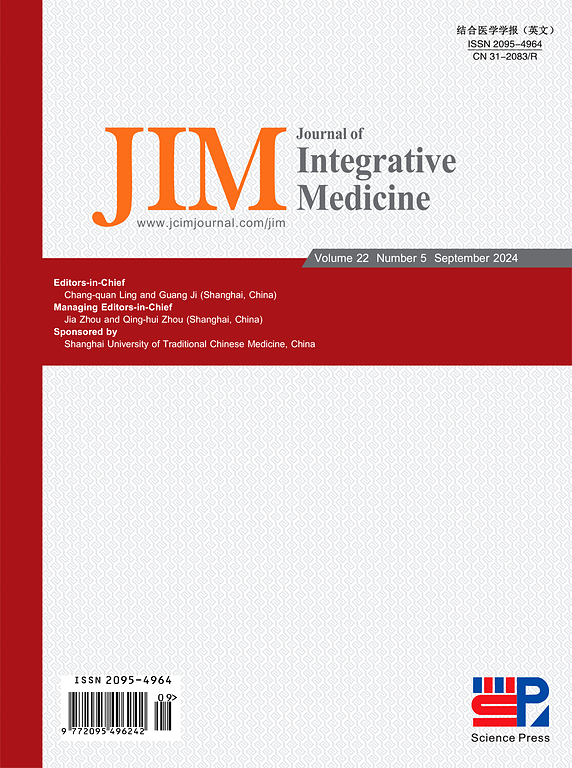A review on mechanistic actions of epigallocatechin-3-gallate in targeting the ominous octet of type 2 diabetes mellitus
IF 4
2区 医学
Q1 INTEGRATIVE & COMPLEMENTARY MEDICINE
引用次数: 0
Abstract
Epigallocatechin-3-gallate (EGCG), a prominent plant-based catechin predominantly derived from Camellia sinensis and widely available on the market as a health supplement, has garnered significant attention for its potential therapeutic benefits, particularly in the context of type 2 diabetes mellitus (T2DM). This review explores the multifaceted role of EGCG in addressing the “ominous octet”—the 8 core pathophysiological defects associated with T2DM. The literature search was carried out using key terms “EGCG” OR “epigallocatechin-3-gallate” OR “epigallocatechin gallate” AND “diabetes” OR “insulin resistance” OR “hyperglycemia” in the PubMed and Scopus databases. The search was constrained to articles published between January 2018 and April 2024, focusing on the document type. Full-text articles published in English and relevant to EGCG that featured a single active ingredient, included clearly explained diabetes relief mechanism, and included ominous octet aspects were included in the final review. The outcomes of the included studies were reviewed and categorized based on 8 core pathophysiological defects, collectively referred to as the ominous octet in T2DM. This review concludes that EGCG is a potent hypoglycemic agent that has beneficial effects against the ominous octet in addition to its pharmacological activities in modulating gut microbiota dysbiosis, carbohydrate digestion and metabolism, glucose transporter-mediated intestinal glucose-uptake, endothelial dysfunction, and renal damage that are significantly associated with pathogenesis of T2DM. This extensive scientific evidence suggests that EGCG may offer a novel approach to traditional antidiabetic therapies, potentially improving glycemic control and mitigating complications associated with T2DM. The inhibitory effects of EGCG on sodium-glucose transport proteins and their role in reducing renal glucose reabsorption remain unexplored, highlighting a significant research gap. Future research should also aim to broaden the scope by investigating the “egregious eleven,” which comprise a more comprehensive range of diabetic pathophysiological features. This review underscores the therapeutic promise of EGCG for managing T2DM and encourages ongoing research to fully elucidate its clinical applications.
Please cite this article as: Wong CN, Lim YM, Liew KB, Chew YL, Chua AL, Lee SK. A review on mechanistic actions of epigallocatechin-3-gallate in targeting the ominous octet of type 2 diabetes mellitus. J Integr Med. 2025; 23(4): 344–356.
表没食子儿茶素-3-没食子酸酯治疗2型糖尿病的机制研究进展。
表没食子儿茶素-3-没食子酸酯(EGCG)是一种重要的植物基儿茶素,主要来源于茶树,作为一种健康补充剂在市场上广泛使用,因其潜在的治疗益处而受到广泛关注,特别是在2型糖尿病(T2DM)的背景下。这篇综述探讨了EGCG在解决与T2DM相关的8个核心病理生理缺陷中的多方面作用。在PubMed和Scopus数据库中使用关键词“EGCG”或“没食子儿茶素-3-没食子酸酯”或“没食子儿茶素没食子酸酯”和“糖尿病”或“胰岛素抵抗”或“高血糖症”进行文献检索。搜索仅限于2018年1月至2024年4月之间发表的文章,重点关注文档类型。最终审评中纳入了与EGCG相关的英文全文文章,这些文章具有单一活性成分,包括明确解释糖尿病缓解机制,包括不祥的八元体方面。对纳入研究的结果进行回顾,并根据8个核心病理生理缺陷进行分类,这些缺陷统称为T2DM的不祥八组。这篇综述得出结论,EGCG是一种有效的降糖剂,除了在调节肠道微生物群失调、碳水化合物消化和代谢、葡萄糖转运体介导的肠道葡萄糖摄取、内皮功能障碍和肾脏损害方面的药理活性外,还对不祥的八糖体有有益的作用,这些与T2DM的发病机制有显著的关系。这一广泛的科学证据表明,EGCG可能为传统的降糖治疗提供一种新的方法,可能改善血糖控制并减轻T2DM相关的并发症。EGCG对钠-葡萄糖转运蛋白的抑制作用及其在减少肾葡萄糖重吸收中的作用仍未被探索,这凸显了一个重大的研究空白。未来的研究还应致力于通过调查“十一个异常”来扩大范围,这些异常包括更全面的糖尿病病理生理特征。这篇综述强调了EGCG治疗T2DM的前景,并鼓励正在进行的研究充分阐明其临床应用。黄春宁,林玉明,刘国宝,周永良,Chua AL, Lee SK.表没食子儿茶素-3-没食子酸酯治疗2型糖尿病的机制研究进展。集成医学[J];打印前Epub。
本文章由计算机程序翻译,如有差异,请以英文原文为准。
求助全文
约1分钟内获得全文
求助全文
来源期刊

Journal of Integrative Medicine-Jim
Medicine-Complementary and Alternative Medicine
CiteScore
9.20
自引率
4.20%
发文量
3319
期刊介绍:
The predecessor of JIM is the Journal of Chinese Integrative Medicine (Zhong Xi Yi Jie He Xue Bao). With this new, English-language publication, we are committed to make JIM an international platform for publishing high-quality papers on complementary and alternative medicine (CAM) and an open forum in which the different professions and international scholarly communities can exchange views, share research and their clinical experience, discuss CAM education, and confer about issues and problems in our various disciplines and in CAM as a whole in order to promote integrative medicine.
JIM is indexed/abstracted in: MEDLINE/PubMed, ScienceDirect, Emerging Sources Citation Index (ESCI), Scopus, Embase, Chemical Abstracts (CA), CAB Abstracts, EBSCO, WPRIM, JST China, Chinese Science Citation Database (CSCD), and China National Knowledge Infrastructure (CNKI).
JIM Editorial Office uses ThomsonReuters ScholarOne Manuscripts as submitting and review system (submission link: http://mc03.manuscriptcentral.com/jcim-en).
JIM is published bimonthly. Manuscripts submitted to JIM should be written in English. Article types include but are not limited to randomized controlled and pragmatic trials, translational and patient-centered effectiveness outcome studies, case series and reports, clinical trial protocols, preclinical and basic science studies, systematic reviews and meta-analyses, papers on methodology and CAM history or education, conference proceedings, editorials, commentaries, short communications, book reviews, and letters to the editor.
Our purpose is to publish a prestigious international journal for studies in integrative medicine. To achieve this aim, we seek to publish high-quality papers on any aspects of integrative medicine, such as acupuncture and traditional Chinese medicine, Ayurveda medicine, herbal medicine, homeopathy, nutrition, chiropractic, mind-body medicine, taichi, qigong, meditation, and any other modalities of CAM; our commitment to international scope ensures that research and progress from all regions of the world are widely covered. These ensure that articles published in JIM have the maximum exposure to the international scholarly community.
JIM can help its authors let their papers reach the widest possible range of readers, and let all those who share an interest in their research field be concerned with their study.
 求助内容:
求助内容: 应助结果提醒方式:
应助结果提醒方式:


